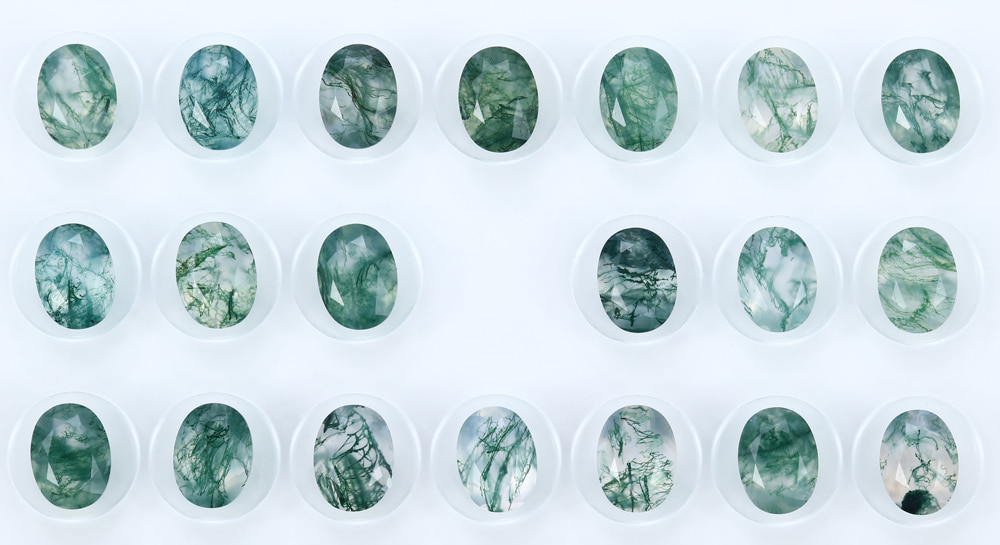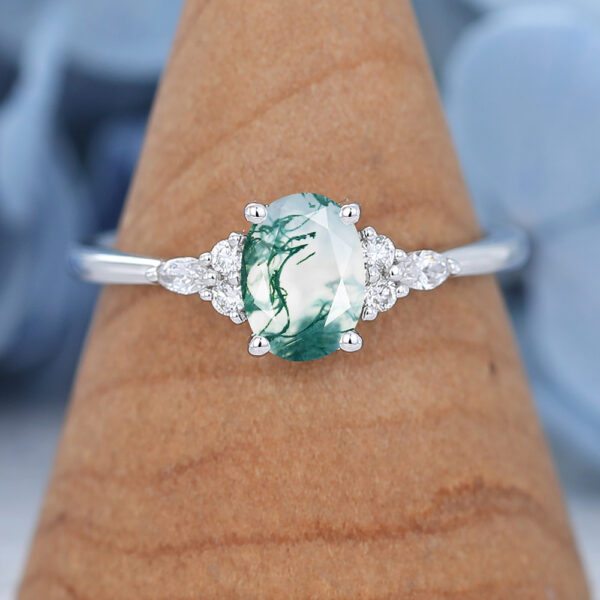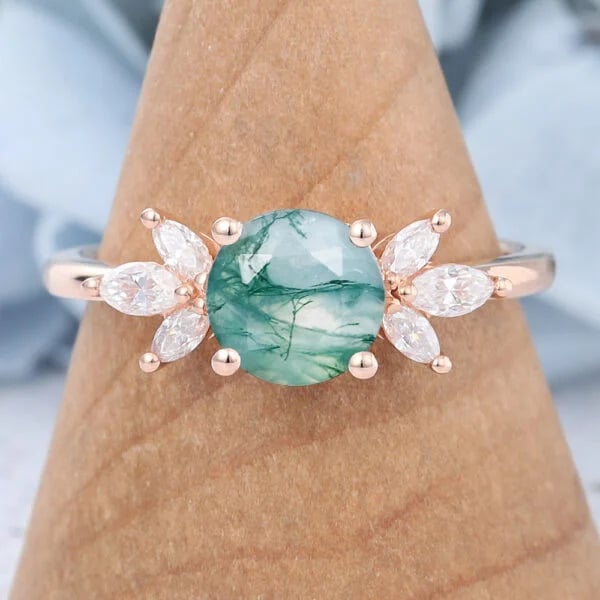In the world of gemstones, where brilliance often steals the spotlight, a quiet and mesmerizing beauty is carving its place—the moss agate. Its understated elegance, with its intricate patterns resembling nature’s verdant artistry, has captivated admirers and gained a quiet yet undeniable popularity in the realm of jewelry. Moss agate is a unique and eye-catching gemstone that is becoming incredibly popular as a material for engagement rings nowadays. In this blog, we explore the reasons why moss agate has become popular for engagement rings and factors to consider when choosing one.
what is moss agate?
Moss agate is a type of chalcedony, which is a variety of quartz. What makes moss agate distinctive is its appearance—characterized by unique green or brownish inclusions that resemble moss or fern-like patterns. These inclusions are typically made of minerals like hornblende or chlorite.
The patterns within moss agate stones often create a sense of natural landscapes or scenes captured within the stone, which makes each piece unique. It’s a popular choice for jewelry making, as its earthy appearance and intricate patterns add a natural and rustic charm to rings, pendants, and other accessories.
How is moss agate formed?
Moss agate forms through a combination of mineral deposits and geological processes over time. Let’s delve into the process of how this captivating gemstone is formed.
Volcanic Activity or Sedimentary Deposits: Moss agate typically forms in cavities or voids within volcanic rocks, such as lava flows, or in sedimentary environments where silica-rich solutions can seep into cracks and spaces.
Silica Deposition: Over time, silica-rich fluids containing dissolved silica dioxide (SiO2) permeate these cavities. As the fluids cool and the silica begins to precipitate out, it forms microscopic quartz crystals, creating the base of the agate.
Inclusions Formation: Alongside the silica deposition, minerals like hornblende or chlorite are present in these solutions. These minerals, when trapped within the forming agate, create green or brownish inclusions resembling moss or fern-like patterns. The specific conditions and chemical compositions dictate the patterns and colors formed within the agate.
Pressure and Temperature Changes: Throughout the formation process, variations in pressure and temperature contribute to the formation of different patterns and colors within the moss agate.
Why choose moss agate over glittering diamond?
While diamonds continue to be a symbol of enduring beauty, moss agate offers a distinct and enchanting alternative. The reason is the extraction of this gemstone usually has a minimal impact on the environment compared to diamonds, which sometimes involve complex supply chains and mining practices. Each moss agate is a one-of-a-kind creation, which means that two identical moss agates cannot be found in the world, just like your unique love story. In addition, in contrast to the high price tag often associated with diamonds, moss agate offers an affordable yet elegant alternative.
The Pros and Cons of Moss Agate Rings
Like any gemstone, they come with their own set of pros and potential cons. Let’s delve into the pros and cons of owning a moss agate ring to help you make an informed choice when considering this distinctive gemstone.
Pros
Unique Aesthetic Appeal: Moss agate rings showcase stunning and individualistic patterns due to their natural inclusions. Each stone possesses a distinctive and beautiful design, making it a unique choice for jewelry.
Affordability: Compared to traditional precious stones like diamonds or emeralds, moss agate tends to be more budget-friendly. This affordability allows for elegant and eye-catching jewelry without the higher price tag.
Connection to Nature: Moss agate’s earthy tones and organic patterns resonate with those who appreciate nature’s beauty. For individuals seeking jewelry that reflects a connection to the natural world, moss agate holds a special allure.
Versatility: Its natural appearance makes moss agate versatile, and suitable for both casual and formal wear. The diverse patterns and colors allow for a range of design possibilities in jewelry making.
Metaphysical Beliefs: Some individuals believe moss agate possesses metaphysical properties, associating it with promoting balance, grounding, and a connection to nature’s energies.
Cons
Durability: Moss agate is not as hard as some other gemstones, like diamonds, which could make it more prone to scratches or damage over time, especially if worn regularly without proper care.
How to choose moss agate engagement rings?
Choosing a moss agate engagement ring involves considering various factors to ensure you find a piece that reflects your style, preferences, and the symbolism of your commitment.
Choosing Your Gemstone
Moss agate has a captivating pattern and earthy tones that make it stand out in the world of gemstone jewelry. Each moss agate has its own distinctive and unique inclusions. Some translucent stones have thick and dense inclusions that evoke a sense of nature’s beauty. While others may prefer a slightly opaque appearance. Look closely at the unique characteristics of each stone until find that single stone that resonates with you.
stone shape
Moss agate comes in a variety of shapes such as oval, hexagon, or kite-shaped. Additionally, in terms of popularity, oval-cut moss agate rings are sought after by brides-to-be. The timeless charm of the oval shape and the elegance of the water and grass combine perfectly. When worn as an engagement ring it creates the illusion of longer fingers and highlights the natural beauty of the stone.
Style And Design
Select a ring setting that enhances the beauty of the moss agate. Options range from classic solitaires to more intricate designs with additional accent stones. The marriage of moss agate’s natural and distinctive patterns with the brilliance of moissanite creates an elegant and eye-catching ring.
metal
Choose the metal of your ring setting based on your preference, skin tone, and budget. Common options include silver and gold (yellow, rose, or white gold). Yellow gold perfectly complements moss agate, rose gold pairs well with the earthy tones of moss agate, white gold adds elegance, and silver is affordable.
Conclusion
As moss agate rings weave their way into the jewelry scene, they bring with them a sense of mystery and individuality. Nature’s artistry encapsulated in each stone, the affordability that doesn’t compromise elegance, and the potential metaphysical allure—all contribute to the rising popularity of moss agate. Choosing a moss agate ring is a journey of self-discovery and connection to the beauty of nature. By considering the stone’s quality, the setting, and the ring’s metal, you’ll find that a moss agate ring will not only adorn your hand but will also showcase your personality and style. For this reason, if you’re looking for a unique and nontraditional piece, a moss agate engagement ring is an ideal choice.
FAQs
Each moss agate stone is distinct, showcasing its own intricate and mesmerizing patterns resembling moss or ferns. Moss agate is becoming a popular trend in engagement rings. This stone appeals to those seeking a unique and meaningful engagement ring due to its unique characteristics and rich symbolism.
Moss agate has a Mohs hardness score of about 6.5-7, which means it is hard enough for daily wear. Although moss agate is relatively soft compared to diamonds, you can extend its lifespan by following the proper care and maintenance tips.
Moss agate is a popular choice for engagement rings due to its several symbolic meanings. It is often believed to represent a connection to nature, growth and new beginnings, abundance and prosperity, and harmony and balance.
Moss agate is generally considered more affordable compared to some traditional precious gemstones like diamonds, rubies, or sapphires. The cost of moss agate can vary depending on factors such as quality, size, clarity, and the intricacy of the moss-like patterns within the stone.







